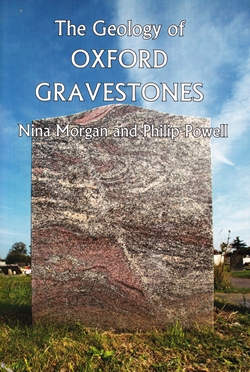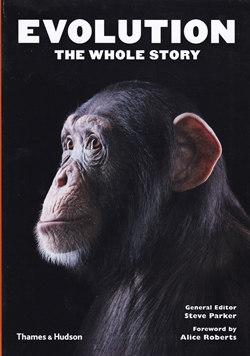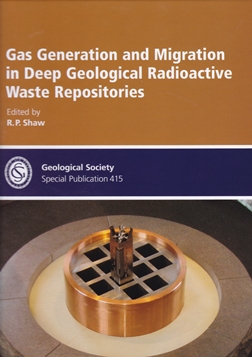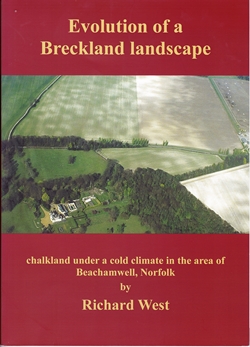 The Geology of Oxford Gravestones
The Geology of Oxford Gravestones
This lavishly illustrated compendium of gravestones in six Oxford graveyards combines two of my favourite things – beautiful rock and dead people – so it was always going to be a winner with me. Written by Nina Morgan (who writes the Distant Thunder column in this magazine) and Philip Powell (former curator at the Oxford University Museum of Natural History and the author of The Geology of Oxfordshire), it combines good writing with in-depth and accurate geological explanations of the textures and structures on display on these delightful memorials.
The book, dedicated to Eric Robinson, doyen of the genre, deals with the Church of St Thomas the Martyr, St Sepulchre’s Cemetery, Holywell Cemetery, the Church of St Mary and St John, Headington Municipal Cemetery and St Andrew’s Church Headington. It commences with a short introduction, a handy location map, and a stratigraphic column indicating the ages of rocks represented. Then comes a gazetteer, cemetery by cemetery, of the more interesting tombs, a glossary and index. Each tomb is shown in more than one aspect, including close-ups where required to show features. Each rock type is diagnosed, with sections on ‘composition’ and ‘what to look for’.
One of the delights of Oxford is the fact that its cemeteries contain with more interesting dead people per square foot than the average British city. So the eponymous occupants are also given brief life-histories, adding human interest. Opening the book more or less at random, I come upon, for example, composer and Professor of Music at Oxford, John Stainer. (George Bernard Shaw, in his music criticism, never omitted the ‘Professor’, as a mark of his contempt).
This worthy gent, perhaps still wearing his pince-nez, is (we learn under ‘Composition’), currently decomposing beneath a Celtic wheel-cross in Peterhead Granite. Very fine it is too, a fitting place of pilgrimage for all those choral society members forced to sing his oratorio ‘The Crucifixion’. Now, should any of them bring a hand lens with them, they can admire its K-feldspars and silvery micas too.
But the reason for choosing the gravestones is primarily geological, so it’s not only academics and other toffs who get mentioned. The diversity of rock-types is also impressive, ranging from Precambrian to Lower Cretaceous. Nor do the authors shy from the odd terracotta memorial. Mike Tomlinson’s beautiful photographs amply complement the text and together they make a fitting tribute to some superb examples of the stonemason’s art.
Reviewed by Ted Nield
THE GEOLOGY OF OXFORD GRAVESTONES by NINA MORGAN & PHILIP POWELL Geologica Press 2015 ISBN 978-1-919158-53-1 List Price: £14.99 140pp, sbk. Copies available from the authors. See www.gravestonegeology.uk for information on how to purchase.
 Evolution - the whole story
Evolution - the whole story
When I received Evolution: the Whole Story, I was initially struck by its superb visual impact. The quality of the pictures and photographs is most impressive and encourages one to read further. The timelines and illustrations are excellent in enhancing the text, and effectively link one’s understanding of the geological timeline to the process of evolution. Similarly, the text in the book is gripping in its description of how the Earth came into being and how life commenced, has been challenged, has changed and continued. From the moment I started the Introduction, I found myself learning about geological history. It is hard to categorise this as a textbook, as the writing is so approachable and user-friendly. One almost feels that one is learning by accident!
The book takes the reader from the very start of the Earth history and reveals life emerging from simple beginnings. Although the details of each species would not be sufficient to fully research them individually, as a narrative of the whole story, it brings evolution to life. Evolution: the Whole Story is most valuable in the way that it links the various stories of life together. It is a useful resource, for those who are familiar with evolution as a scientific theory, and wish to link this with geological history.
An understanding of the process of evolution would be a must to get the best use out of the book, though the basics are explained clearly, and there is a clear and concise glossary at the end for those needing guidance with the evo-jargon.
If I have one complaint, it would be about tendentious use of language: sometimes it falls into the trap of discussing features as though they were 'designed', and that variations are 'chosen' by individuals in order to make life easier for the species! For example, the chapter 'Mosses and Ferns', the author states: “As a partial solution, bryophytes evolved the process of reproduction that takes place in two phases….” (p. 67). I feel that this makes the evolutionary process seem deliberate and conscious, which is clearly inappropriate.
My overall impression of Evolution: the Whole Story is highly favourable and I know that I will continue to derive much use and pleasure from it. In the words of Alice Roberts, who provided the forward: “We’re all tiny twigs on the great Tree of Life.” This book certainly puts us in our place!
Reviewed by Sarah Pipkin
EVOLUTION: THE WHOLE STORY edited by STEVE PARKER, 2015. Published by: Thames and Hudson 575pp (softback) ISBN: 978-0-500-29173-3 LIST PRICE: £19.95
 Gas generation and Migration in Deep Geological Radioactive Waste Repositories
Gas generation and Migration in Deep Geological Radioactive Waste Repositories
Understanding the behaviour of gases within the environment of a proposed deep geological radioactive waste disposal site is a fundamental factor in underpinning a robust repository safety case. This knowledge is of particular importance in assessing the performance of crystalline rocks, indurated mudrocks and plastic clays (the ‘far field’) that may be considered as suitable host formations for the waste. Additionally, understanding the long term behaviour of the engineered clay (bentonite) buffer and cement-based backfill media used to encapsulate and surround the primary waste containers (the ‘near-field’) is pivotal.
This Special Publication summarises the recent research studies addressing these issues that were undertaken primarily within the EU Euratom programme FORGE (‘Fate Of Repository GasEs’) project. The project examined these issues as five inter-related work packages, establishing new quantitative experimental data and modelling parameters through a series of laboratory and field-scale experiments conducted at several underground research facilities located throughout Europe.
The outcomes of the work packages are presented as 17 papers covering key topics on gas generation (including the definition of long-term metal corrosion rates under repository conditions), processes and mechanisms controlling gas migration in clay and cement-based engineered barriers and undisturbed host rock, the effects of elevated gas pressures on the movement of groundwater and aqueous-borne contaminants, the role of gas in the ‘near field’ and excavated/disturbed host rock formations, and the identification of any potential coupling effects (feedback factors) that could compromise repository performance. The FORGE project did not study salt host rocks or salt-based backfill materials, however a single paper is presented reviewing the current understanding of gas transport processes within evaporitic formations.
The volume provides an excellent synthesis of the current research within this important area. All papers are well written and edited, concisely laid-out with clear and appropriate figures, photographs and data-tables. The inclusion of numerous colour figures and photographs enhances the understanding of the accompanying text.
The insights presented will be directly relevant to both research students and geoscientists in the field and practising radioactive waste management professionals undertaking potential repository design and performance evaluation, risk assessment and safety case development.
Reviewed by Mark Griffin
GAS GENERATION AND MIGRATION IN DEEP GEOLOGICAL RADIOACTIVE WASTE REPOSITORIES by R P Shaw (editor). Geological Society of London Special Publication No 415. 2015. Geological Society of London. ISBN 978-1-86239-722-4. Hbk. 264pp. ISSN 0305-8719. List Price: £100.00. Bookshop
Evolution of a Breckland Landscape
In many journals there is a restriction on space so that published evidence is limited. Here it has been possible to record the meticulous details of recent fieldwork and to make them readily available to future researchers. These details are followed up with careful discussions leading to interpretations that fit comfortably.
Surprisingly, given the title, Professor West doesn’t start out by explaining what is meant by 'Breckland' – an area of SW Norfolk and NW Suffolk typified by drought-prone alkaline and acid sandy soil supporting sparse grass, gorse, bracken and rows of Scots pine. But this doesn’t detract from the book’s value as, to a large extent, the characteristics of this landscape type will be absorbed from the text supported by 40 pages of photographs.
The author shows that the presence of the Chalk close to surface was fundamental to the evolution of the Breckland, with its unique characteristics. He also reminds us of the properties of different chalk lithologies in terms of weathering and hydrology and he relates these differences to the erosion and other processes that produced some of the larger features here, such as scarps and dry valleys. In piecing together of the evidence in respect of post-Anglian history he shows that a Wolstonian ice-damned lake was very significant in the study area.
As many landscape features are subtle and their clarity fluctuates, the aerial photos are especially helpful in demonstrating the existence and appearance of the poorly understood and somewhat neglected ground patterns (eg polygons, stripes) and other features (eg pingoes). West describes the geometries of these features and the arrangements of lithologies within the features. From this he outlines how the lithologies control soil characteristics (acidity/alkalinity and water retention) and in turn what we see, zones of different vegetation. Importantly, he relates the origin of the features to the effects of permafrost, topography and run-off. West also considers if subtle features formed in the cold Wolstonian period could have and survived and been over-printed or added to when subjected to the later next (the Devensian) cold period.
Richard West will be 90 next year and this book gives testament to his enduring enthusiasm and remarkable abilities. The book is more than the detailed geology of a particular area; it provides interpretations of mid to late Pleistocene geology without the need for the debated 'River Bytham'. It also expands our knowledge on periglacial processes and on the poorly known Wolstonian Period in the UK.
One little irritation - the figures sometimes require flipping from one key to another.
Reviewed by Howard Mottram
EVOLUTION OF A BRECKLAND LANDSCAPE: CHALKLAND UNDER A COLD CLIMATE IN THE AREA OF BEACHAMWELL, NORFOLK by RICHARD WEST, 2015. Published by: The Suffolk Naturalists Society 110pp (sbk): List Price £10.00. W: www.sns.org.uk